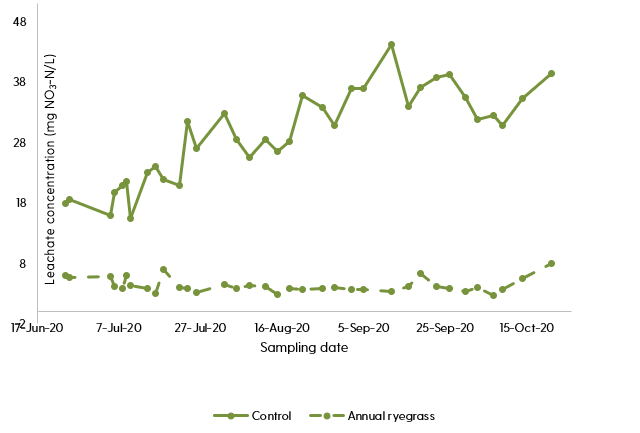The study, conducted by Pioneer Brand Products between October 2018 and October 2021, saw maize planted in spring. Immediately after harvest, some plots were drilled into a range of winter catch crops that included annual ryegrass or left fallow. Throughout the year, N leaching was measured in each plot to a depth of 120cm, using ceramic suction cups and barrel lysimeters.
While maize management followed good standard practice, an additional 200kg N/ha above the recommended rates was applied to the maize crop to allow for excess soil N after harvest in order to have a true measure of N leaching losses. No additional N was applied to the winter option as the left-over N was considered sufficient.
More than 90% of N leaching losses were observed during winter (after maize harvest), and the balance during spring. This result was different in a wetter spring, where plots that measured 200kg mineral N/ha at or around planting time lost 30kg N/ha by December vs 0kg N/ha if starting mineral soil N levels were only 75kg/ha. This result highlights the leaching risks associated with front loading N at or before planting.
Catch crops were found to reduce leaching losses by up to 90% and this can be largely attributed to uptake on soil N, reducing soil concentration, and consequently, leaching risk (Figure 1). Nitrogen leaching losses were much higher in the maize-fallow (>60 kg N/ha) than the maize-annual ryegrass rotation plots.
The leaching losses observed in this study were much lower than results from previous research. One of the key reasons for the difference in the results could be the depth at which the leaching losses were measured. Most previous work conducted N leaching measurements at 60cm, which we considered too shallow given the deeper rooting system for maize.
Part of our study also included a separate-but-related experiment that evaluated comparative leaching losses between measurements conducted at 70cm and 120cm. Over three years, leaching losses were 350% higher on average when measurements were conducted at 70cm, compared to measurements at 120cm.
To prove maize can extract nutrients as far deep as 120cm, another separate experiment comprising nitrogen 15 (15N), a different type of N to the one found in standard fertilisers, was conducted on a Waikato site between 2020 and 2022.
Nitrogen exists as two stable isotopes, 14N (99.6%) and 15N (0.4%). Due to the rarity or negligible levels of 15N in soils, synthetic 15N can be used to trace evidence of maize roots' N uptake from the soil.
The study involved a range of treatments including control and enriched synthetic 15N inserted in maize plots to 60cm, 90cm and 120cm below the soil surface. At harvest, maize plant components (leaves, stalks, grain) from each treatment were sampled to trace 15N uptake. Samples were finely ground through a 100-mesh screen and sent to the UC Davis Stable Isotope Facility (USA) for total N and isotopic 15N composition analysis, using an automated combustion elemental spectrometer.
Significantly greater levels of 15N uptake were observed when 15N was drilled into the maize plots at all three soil depths, compared to control (Table 1). This provided clear evidence that maize roots can grow beyond 120cm and pick up N to that depth.
For more information about this N study, talk to your Farm Source TSR.
__________________________________________________________________________________________________

Figure 1: Nitrate-N concentrations for leachate samples collected from plots planted to a winter catch crop or fallowed after maize silage harvest on an Ash soil in Te Awamutu.
__________________________________________________________________________________________________
| Treatment |
Leaf %15N |
Stalk %15N |
Grain %15N |
|---|---|---|---|
| Control | 0.37d | 0.37d | 0.37b |
| 60cm | 0.79a | 0.85a | 1.14a |
| 90cm | 0.69b | 0.90a | 1.25a |
| 120cm | 0.52c | 0.88a | 1.08a |
Table 1: Percentage of 15N concentrations in maize plant components (leaf, stalk and grain) at grain harvest maturity time on a Waikato ash soil site over two maizegrowing seasons.
Means followed by the same letter within a column are not statistically significant.